🩺 Product Overview
Dapagliflozin 10 mg, Glimepiride 1 mg, and Metformin 1000 mg—this tablet addresses multiple pathophysiological aspects of T2DM, offering enhanced glycemic control and improved patient adherence.
💊 Composition
- Dapagliflozin (10 mg): A Sodium-Glucose Cotransporter-2 (SGLT2) inhibitor that reduces glucose reabsorption in the kidneys, promoting glucose excretion through urine.
- Glimepiride (1 mg): A sulfonylurea that stimulates insulin release from pancreatic β-cells, enhancing insulin secretion.
- Metformin (1000 mg): A biguanide that decreases hepatic glucose production and improves insulin sensitivity in peripheral tissues.
⚙ Mechanism of Action
- Dapagliflozin: Inhibits SGLT2 in the renal proximal tubules, leading to increased urinary glucose excretion and a reduction in blood glucose levels.
- Glimepiride: Binds to ATP-sensitive potassium channels on pancreatic β-cells, causing depolarization and subsequent insulin release.
- Metformin: Suppresses hepatic glucose production and enhances insulin sensitivity, facilitating improved glucose uptake by peripheral tissues.
✅ Indications
DAPA-GM-MET 10/1/1000 Tablet is indicated for:
- Adults with Type 2 Diabetes Mellitus inadequately controlled by diet and exercise alone.
- Patients requiring combination therapy with Metformin and Glimepiride.
- Individuals seeking to minimize pill burden while achieving optimal glycemic control.
📈 Clinical Benefits
- Enhanced Glycemic Control: Targets multiple mechanisms to effectively lower blood glucose levels.
- Reduced Risk of Hypoglycemia: The combination of agents helps mitigate the risk of low blood sugar.
- Cardiovascular and Renal Protection: Dapagliflozin offers additional benefits in heart failure and chronic kidney disease.
- Weight Neutrality: Unlike many anti-diabetic medications, this combination may support weight management.
- Convenience: Combines three medications into a single tablet, improving patient adherence.
📊 Efficacy
A Phase III, open-label, randomized clinical study conducted in India demonstrated that the fixed-dose combination of Dapagliflozin, Glimepiride, and Metformin extended-release tablets significantly reduced HbA1c levels compared to dual therapy with Glimepiride and Metformin prolonged-release tablets. The study reported a mean reduction in HbA1c of -1.98% ± 1.01% in the triple therapy group, compared to -1.64% ± 0.86% in the dual therapy group (p = 0.0047) .
⚠ Precautions
- Renal Function: Regular monitoring of renal function is advised, as Dapagliflozin is contraindicated in patients with severe renal impairment.
- Hypoglycemia: Caution is required when used with other antidiabetic agents that may cause hypoglycemia.
- Lactic Acidosis: A rare but serious side effect associated with Metformin; avoid in patients with conditions that predispose to acidosis.
- Volume Depletion: Dapagliflozin may cause diuresis; ensure adequate hydration.
💊 Dosage and Administration
- Dosage: One tablet once daily with meals, preferably with breakfast.
- Administration: Swallow the tablet whole with a glass of water; do not chew or crush.
- Adjustment: Dosage may be adjusted based on individual patient response and tolerability.
🧾 Side Effects
Common side effects may include:
- Metformin: Gastrointestinal disturbances such as nausea, vomiting, and diarrhea.
- Glimepiride: Hypoglycemia, dizziness, and headache.
- Dapagliflozin: Urinary tract infections, genital infections, and increased urination.
Serious but rare side effects include:
- Lactic Acidosis: Symptoms include muscle pain, respiratory distress, and fatigue.
- Severe Hypoglycemia: Symptoms include confusion, sweating, and rapid heartbeat.
🧪 Drug Interactions
- Alcohol: May potentiate the effect of Metformin and increase the risk of lactic acidosis.
- Diuretics: May increase the risk of dehydration and hypotension when used with Dapagliflozin.
- Insulin and Insulin Secretagogues: May increase the risk of hypoglycemia.
🧑⚕ Use in Special Populations
- Pregnancy and Lactation: Not recommended; consult a healthcare provider before use.
- Geriatric Patients: Use with caution; monitor renal function closely.
- Pediatric Patients: Safety and efficacy have not been established.
🗄 Storage
Store at room temperature, away from moisture and heat. Keep out of reach of children.






Reviews
There are no reviews yet.